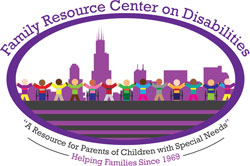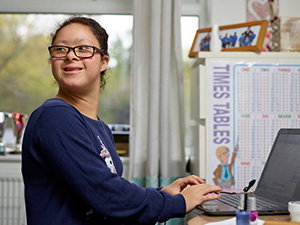 Every child deserves the chance to succeed in school, no matter their abilities. One of the key ways they are doing this is through the use of Assistive Technology (AT). Let’s break down what this means and how it can help your child.
Every child deserves the chance to succeed in school, no matter their abilities. One of the key ways they are doing this is through the use of Assistive Technology (AT). Let’s break down what this means and how it can help your child.
What is Assistive Technology?
Assistive Technology (AT) refers to devices and services that help children with disabilities participate in school activities and learn more effectively. These tools are designed to support students in overcoming challenges they might face due to their disabilities.
For example:
Text-to-Speech Software: This tool reads digital text aloud, helping students who struggle with reading. It can make it easier for them to understand their lessons.
- Natural Reader](https://www.naturalreaders.com/) A versatile TTS software that converts text into spoken words. It supports various formats like PDFs, Word documents, and web pages.
- Google Text-to-Speech (https://play.google.com/store/apps/details?id=com.google.android.tts&hl=en&gl=US) Built into Android devices and used with apps like Google Play Books to read aloud. Supports multiple languages.
- Kurzweil 3000](https://www.kurzweiledu.com/products/software.html ) A TTS tool designed specifically for students with learning disabilities, including dyslexia. It offers text highlighting and natural-sounding voices.
- Voice Dream Reader (https://www.voicedream.com/reader/) A mobile app for iOS and Android that reads text from various sources, including PDFs and web pages. It’s highly customizable with adjustable voices and reading speeds.
- Read&Write https://www.texthelp.com/products/read-and-write A comprehensive literacy support tool that includes TTS, word prediction, and more, designed to assist students with reading difficulties.
Word Prediction Devices: These devices suggest words as students type, which can help those who have difficulty writing or spelling.
- Co:Writer (https://learningtools.donjohnston.com/product/cowriter/) Co:Writer is a word prediction software that suggests words as users type, helping with spelling and writing. It supports multiple languages and offers topic-specific dictionaries
- Ginger Software(https://www.gingersoftware.com/) Ginger is a writing assistant tool that includes word prediction features along with grammar and spell checking. It helps users write faster and more accurately.
- WordQ(https://www.quillsoft.ca/wordq/) WordQ is a word prediction software that helps users with writing
Communication Devices: Some children have trouble speaking. These devices help them communicate with their teachers and classmates, which boosts their confidence and helps them feel more included.
- Tobii Dynavox (https://www.tobiidynavox.com/) Tobii Dynavox offers a range of augmentative and alternative communication (AAC) devices that help individuals with speech and language disabilities communicate. Their devices include eye-tracking technology and touch-based communication systems.
- PRC-Saltillo](https://www.prentrom.com/) PRC-Saltillo provides various communication devices like the Accent series, which are speech-generating devices that allow individuals to communicate using touch screens and symbols. They also offer communication apps like LAMP Words for Life. GoTalk Devices(https://www.attainmentcompany.com/gotalk-communication-devices) GoTalk offers a series of low-tech communication devices that are easy to use and portable. They provide simple, customizable communication boards that are ideal for users of all ages.
- Proloquo2Go(https://www.assistiveware.com/products/proloquo2go) Proloquo2Go is an AAC app for iOS devices that helps individuals who cannot speak or have difficulty speaking to communicate. It is highly customizable with a variety of voices and languages.
Visual Schedules and Timers: These tools help children understand daily routines and manage their time, making it easier for them to participate in classroom activities.
- Time Timer (https://www.timetimer.com/) Time Timer provides visual timers that help individuals understand the passage of time. The timer uses a colored disk that disappears as time passes, making it easy to see how much time is left.
- Choiceworks Visual Schedule(https://www.beevisual.com/choiceworks-schedule/ )The Choiceworks app and visual schedule tool are designed to help children understand and follow daily routines. It allows users to create customized visual schedules with images and timers.
- Boardmaker (https://goboardmaker.com/) Boardmaker offers a variety of visual schedule tools that use picture symbols to help individuals with disabilities follow daily routines. These tools are customizable and can be tailored to individual needs.
- Goally(https://getgoally.com/) Goally is a wearable device and app that provides visual schedules and timers for children with autism and ADHD. It helps them manage daily routines independently by providing visual cues and reminders.
(The resources listed above are examples of Assistive Technology Tools and not an exhaustive list. Work with your IEP Team to determine which AT tool is right for your child.)
Why is Assistive Technology Important?
The Individuals with Disabilities Education Act (IDEA) requires that schools provide the necessary tools and services to help children with disabilities succeed. This means that if your child has an Individualized Education Program (IEP) or an Individualized Family Service Plan (IFSP), the school must consider whether AT devices are needed to help them learn.
- AT is important because it:
Improves Learning: By giving children the tools they need, AT helps them better understand and engage with their schoolwork. - Builds Skills: AT devices can help children develop important skills, such as communication and writing, which are crucial for their future success.
- Encourages Inclusion: When children have the right tools, they can participate more fully in classroom activities, just like their peers.
How Can Parents Support Their Child?
As a parent, you play a vital role in your child’s education. Here’s how you can support your child if they need Assistive Technology:
Learn About AT: Understanding what AT is and how it can help your child is the first step. Talk to your child’s teachers and IEP team about what devices or services might be beneficial.
Advocate for Your Child: If you believe your child could benefit from AT, don’t hesitate to ask for it. Schools are required to provide these tools if they are necessary for your child’s education.
Be Involved: Work closely with the school to ensure that the AT devices are being used effectively and that they are making a positive difference in your child’s learning. Parents can learn about resources provided by the Illinois Assistive Technology Program (IATP) to discuss AT at your child’s next IEP meeting to advocate for the inclusion of assistive technology devices and services that enhance their child’s independence and participation in school. The Illinois Assistive Technology Program (IATP) help individuals obtain AT through our customized 3D printing fabrication program and AT reuse program. IATP provide training, technical assistance, and a variety of contracted services including professional AT evaluations. Parents can ensure that their child’s IEP includes tailored solutions that meet their specific needs. Learn more at https://iltech.org/.
Assistive Technology is a powerful tool that can help children with disabilities overcome challenges and succeed in school. By understanding and supporting the use of AT, parents can help their children achieve their full potential and create a more inclusive and supportive learning environment. Remember, every child deserves the opportunity to learn and thrive, and with the right tools, they can.

